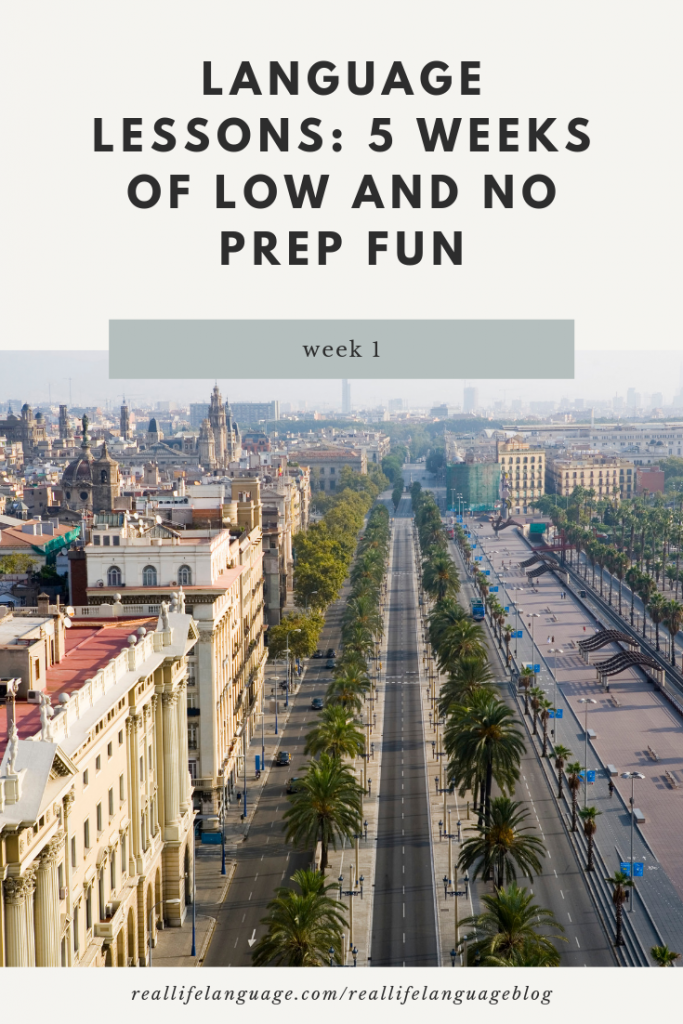
Language Lessons: Five Weeks of Low and No Prep Fun- Week One
The following activities and language lessons can be used in any language class and with any vocabulary theme. They’re designed to be flexible enough to work in the novice, intermediate and advanced levels as well.
A short description of each activity as well as examples of how they can be used at each of the major proficiency ranges (novice, intermediate and advanced ranges/CEFR A, B, and C).
White Boards
White boards are a great investment for your classroom. I love small rectangular ones and use dry erase markers. They can be used for so many engaging language lessons. They work great for quick reviews and a fun check in to see what everybody knows at any point in the class.
Here are just a few ways that they can be used in your language lessons:
Beginning/A: Use these to practice verbs and vocab. Students can get much-needed practice conjugating verbs. You instantly see when they hold up their board if they got it wrong or right. Vocabulary study can be something as fun as you say a word and they do a quick doodle on their board to show you they know what it means.
Intermediate/B: Following on the idea of drawing what you say, you can give much more detailed descriptions using vocabulary from whatever theme you’re studying and the students have to draw. For example, you might have them draw a table setting if you’re studying food or restaurants, or a house when you’re teaching that theme in your language lesson.
Advanced/C: Students can illustrate and create a chain story. Divide the students up into teams, large or small. Distribute some different themes or keywords. The students have to draw what’s on their paper and illustrate what’s happening and then as a group, they come together and create a story in the target language, which they then tell and share with the class. Sort of like Mad Libs- lots of fun and lots of laughter.
Hollywood Stars
Actors and language learners have a lot in common. Lots of practice and lots of studying your lines is needed so that you get to a point where you will never forget them. They make the perfect vehicle for language lessons.
Beginner/A: Dialogues. These are great from your textbook. The students have to master a role in the dialogue and perform it. They build up enough of those words and phrases and they will easily move into the intermediate level.
Intermediate/B. We start creating at the intermediate level. Students can write, memorize, and present their own script. They will practice all skills in a language lessons designed around this activity.
Advanced/C. I love having students do monologues. Actors have to prepare many monologues for their repertoire in order to audition for jobs. Monologues are great because students have to remember a lot of words and really breathe life into them when they perform them. It’s a great activity in reading and speaking fluency.
Post-its
These are a language learner and teachers’ best friend. There are so many engaging and effective language lessons that can be done with them.
Beginning/A: have students label items. This can be a lot of fun. It can be as simple as handing a pack of post-it notes to a group of students and have them label all of their school supplies or maybe different items in your classroom. They can do the same with clothes, food, any theme of vocabulary that you’re studying that they can see and label or even draw and label.
Intermediate/B. Again, students create at the intermediate level. I love using post-its to create talking points. For example, I might give a group of students a pack of post-it notes and ask them each to take two or three and bullet point out some things they know how to say about a certain thing.
This is really important for intermediate learners because they can’t always speak to the extent that they want without a bit of preparation. They can then collect all of their post-it notes with their group and brainstorm about the conversation that they’re going to have. They then use their phone or a simple recorder and have a three or four minute conversation. It’s great practice.
Advanced/C. Advanced speakers can speak extended paragraphs. I think this is really fun if you have a class of people really willing to talk and be a little bit silly.
I love Problem Parking Lot. Of course, at the advanced level, we do lots of tasks which involve advising tactfully. I usually have students write down problems that aren’t really theirs.
Tell them to get creative and they should write them on big post-it notes. They then have to place their post-it notes in the parking lot. Every student then takes someone else’s problem and goes back to their seat. They read through the problem and formulate a response. We then sit in a circle and share the problem and the solutions. This language lesson incorporates all skills and helps them develop extended discourse.
Looking for more low prep activities for your language classes? Check out them out here.